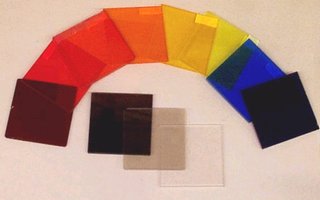Filter (optics)
|
|
An optical filter is a device which selectively transmits light having certain properties (often, a particular range of wavelengths, that is, range of colours of light, or polarizations), while blocking the remainder. They are commonly used in photography, in many optical instruments, and to colour stage lighting.
Colour filters are usually made from glass to which various inorganic or organic compounds have been added. These compounds absorb some wavelengths of light while transmitting others. The compounds can also be added to plastic (often polycarbonate or acrylic) to produce gel filters, which are lighter and cheaper than glass-based filters.
Alternately, reflective filters can be made by coating a glass substrate with an optical coating. These filters reflect the unwanted portion of the light and transmit the remainder. Reflective filters are particularly suited for high-precision scientific work, since their exact filter band can be selected by precise control of the coating. They are however, usually much more expensive and delicate than absorption filters. Coating-based filters are often referred to as dichroic, and can be used in devices such as a dichroic prism to separate a beam of light into different coloured components.
Monochromatic filters only allow a narrow range of wavelengths (that is, a single colour) to pass.
Infrared (IR) or heat-absorbing filters are designed to block mid-infrared wavelengths but pass visible light. They are often used in devices with bright incandescent light bulbs (such as slide and overhead projectors) to prevent unwanted heating. There are also near-infrared filters which are used in solid state video cameras to compensate for the high sensitivity of many camera sensors to near-infrared light.
Ultraviolet_Filters-Courtesy_NASA-JPL-Caltech.jpg
Ultraviolet (UV) filters block ultraviolet radiation, but let visible light through. Because photographic film and digital sensors are sensitive to ultraviolet (which is abundant in skylight) but the human eye is not, such light would, if not filtered out, make photographs look different from the scene that the photographer saw. This causes images of distant mountains to appear hazy. By attaching a filter to remove ultraviolet, photographers can produce pictures that more closely resemble the scene as seen by a human eye.
Neutral density (ND) filters have a constant attenuation across the range of visible wavelengths, and are used to reduce the intensity of light by reflecting or absorbing a portion of it. They are specified by the optical density (OD) of the filter, which is the negative of the common logarithm of the transmission coefficient. They are useful for making photographic exposures longer. A practical example is making a waterfall look blurry when it's photographed in bright light. Alternatively, the photographer might want to use a larger apperature (so as to limit the depth of field); adding an ND filter permits this. ND filters can be reflective (in which case they look like partially-reflective mirrors) or absorbative (appearing grey or black).
Longpass (LP) Filter is an optical interference or colored glass filter that attenuates shorter wavelengths and transmits (passes) longer wavelengths over the active range of the target spectrum (ultraviolet, visible, or infrared). Longpass filters, which can have a very sharp slope (referred to as edge filters), are described by the cut-on wavelength at 50 percent of peak transmission. In fluorescence microscopy, longpass filters are frequently utilized in dichromatic mirrors and barrier (emission) filters. Use of the older term of highpass to describe longpass filters is now discouraged because it more accurately refers to frequency rather than wavelength.
Shortpass (SP) Filter is an optical interference or colored glass filter that attenuates longer wavelengths and transmits (passes) shorter wavelengths over the active range of the target spectrum (usually the ultraviolet and visible region). Shortpass filters, which can have a very sharp slope (referred to as edge filters), are described by the cut-off wavelength at 50 percent of peak transmission. In fluorescence microscopy, shortpass filters are frequently employed in dichromatic mirrors and excitation filters. Use of the older term of lowpass to describe shortpass filters is now discouraged because it more accurately refers to frequency rather than wavelength.
Another kind of optical filter is a polarization filter, which blocks or transmits light according to its polarization. They are often made of materials such as Polaroid and are used for sunglasses and photography. Reflections, especially from water and wet road surfaces, are partially polarized, and polarized sunglasses will block some of this reflected light, allowing an angler to better view below the surface of the water and better vision for a driver. Light from a clear blue sky is also polarized, and adjustable filters are used in colour photography to darken the appearance of the sky without introducing colours to other objects, and in both color and black-and-white photography to control specular reflections from objects and water.
Polarized filters are also used to view certain types of stereograms, so that each eye will see a distinct image from a single source.

